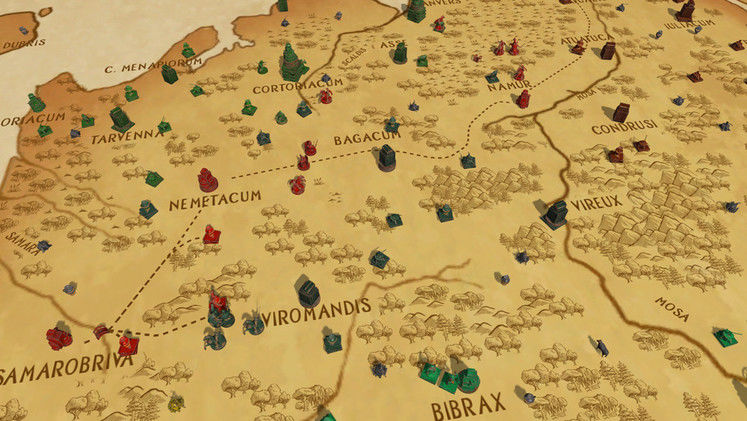 |
| The campaign map viewed from the 'strategic' level. You can seamlessly zoom in and out between this mode, and the 3D rendered view |
The engine behind the game looks very slick at the moment – zoomed out, it represents an old school paper map of the area, almost like a board-game, and there are chess-like pieces that represent your towns and your armies. The armies move in real-time across the map, assuming you’ve given them orders, but you can also zoom right in where the view changes in the 3D battle environment. Here you’ll be able to see your armies and units in more detail, see the towns and forts, and the terrain, and get a more close-up view of the action.
As we mentioned above, there’s a large focus on combat, but also the logistical challenges that come with maintain armies and terrain. Supply lines are key, and you can have your armies disrupt and/or blockade supply routes to deny enemy forces their supplies, or starve out a town to make it easier to take. Rivers form key borders along the map, and thus the bridges that cross them are focal points for control. There is a number of fort ‘slots’ around the map that you can choose to build fortifications on to help control your territory easier. Armies, towns and forts can be set to different ‘stances’, which have differing bonuses and effects.
Rome is the sequel to Hegemony: Wars of Ancient Greece (and its expansion, which are now collectively called Hegemony: Gold), and the previous game had a number of issues associated with it that the team have tried to address this time around. Work has been done on the AI so that it too is trying to conquer the world, the same as you. You should be challenged in your quest for domination, not just ticking down the moments till your inevitable victory. There’s also a few more tools for you to manage larger empires – the forts that we mentioned can be used for defending borders instead of using an army that you have to control, meaning you shouldn’t have too much to think on all at once.
 |
| An example of a 'fort' ot 'camp' that you can build. Different from the towns & cities, these bases can help control vital areas and supply lanes |
Hegemony Rome is shaping up to be a decent enough game right now. It’s going to be rough around the edges, and even with the 25 factions, I reckon replay value is going to be limited, unless they really make the factions feel different. Still, it’s an interesting twist on the wargame framework, with a rarely covered setting (The Gallic Wars specifically, not the roman period), and hopefully the mechanics will support what we’ve seen so far. At the time of writing, Hegemony Rome: The Rise of Caesar is due out on PC early 2014.
Most Anticipated Feature: To see how the late game plays out, and whether the logistics system is as good as they say.




